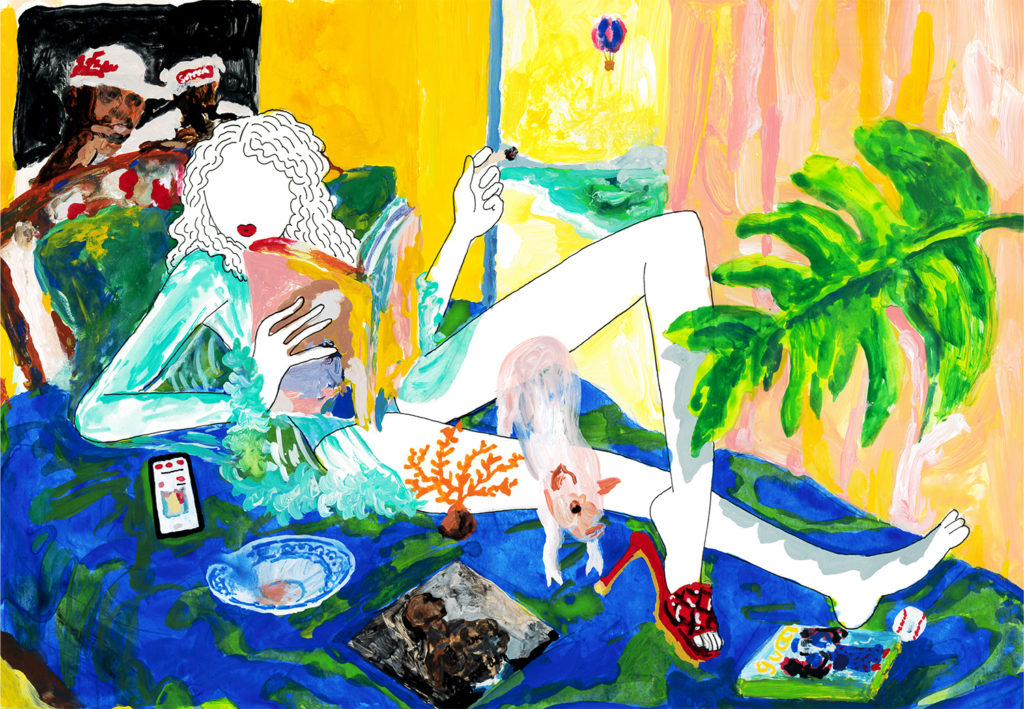When we look at the relationship between music and fashion, as well as between fashion trends and youth culture, we get a clearer understanding of the times we live in. In this series, Tsuya-chan, an up-and-coming writer, analyzes current cultural events by examining contemporary music with a focus on Japanese hip-hop.
For the 17th installment, the last one of the series, she gets to the core of the music of Japanese women rappers by referencing the notion of iki (chicness). She also looks at the year 2009, which was a turning point, through the lens of fashion history.
Analyzing the imaginative power of hip-hop (history) through fashion
In this series of columns, I’ve uncovered how contemporary music—namely hip-hop, which has been active in recent years with its raw spirit—has woven an inseparable relationship with fashion. If I’ve been able to reveal how hip-hop subconsciously/deeply breathes in sync with fashion one way or another, then the purpose of this series has been reached.
When I talk about the marriage of the two, I’m not only referring to the changes that have taken place, like the convergence of high fashion and streetwear post-2010s, which drastically shook the existing class structure and the fact that rappers and dancers came to wear luxury brands. I don’t wish to emphasize the repeated attempts to reinforce hip-hop attitudes with lyrical references that use brands like Gucci and Chanel, either. What I want to state is thus: the sound and history of brand names like Gucci and Chanel create a narrative, and hip-hop has become an autonomous art form with an unexpected vibrancy.
The same is true for fashion staples such as sneakers and jeans, which I spoke about in the penultimate installment. Without a doubt, these items, originally from streetwear, have been redefined and given a new context as of late. Hip-hop is enmeshed with these items in a way that can’t be labeled as a mere trend. The sneakers that rappers wear carry the core idea of hip-hop, which is the “reversal of black and white.” When one drags a pair of sagging jeans on the streets, they’re followed around by something that upholds the essence of hip-hop, which is the unchangeable origin of oneself. Imagination is far superior to reality. The imagination of hip-hop (history) can provide a grand story by using fashion as a symbolic tool.
The concept and aesthetic of iki underlying the music of Japanese women rappers
As TOKION is a platform that introduces “cutting edge culture,” I brought to life the entangled play between hip-hop and fashion through rap music in Japan. If there’s one last point I should explore, it’s the notion of iki (chicness), which upholds Japanese fashion, and the influence that this fleeting (and therefore hard to grasp) aesthetic has on hip-hop. This approach in hip-hop, introduced by many women rappers, hasn’t been in the spotlight because of its subtleness and difficult-to-understand nuance. During the Edo period, when the concept of iki prospered, the structure of hierarchal society was dominant, and modesty was encouraged thanks to the sumptuary law. The iki culture and aesthetic that blossomed under the oppressive environment is similar to women rappers in the male-centric hip-hop game in the form of a pyramid, who have expressed themselves despite being ridiculed as being soft at times. And this isn’t common in women rappers in America.
To be iki is to alter something. While the most prominent male rappers in Japanese hip-hop history have been rhyming stoically, a small number of male and women rappers have been showcasing a playful and laidback style compared to their solemn counterparts. Starting with ORCHIDS, who debuted on MAJOR FORCE, to FUNKY ALIEN, HAC, YURI, HALCALI, Y.I.M, and chelmico, the laidback rap style that strays away from hip-hop’s stylistic beauty, has introduced a new perspective of changing the rap game.
Additionally, iki also equates to sexiness. Hiroshige Utagawa’s “After a Bath” is a well-known example of how one could find many instances of flushed women after taking a bath, considered as iki culture, in ukiyo-e paintings, which flourished during the Edo period. The Edo culture carefully illustrated the warmth of their exposed bodies and sighs and the sexiness of their unguarded intimacy. As such, the ways Daoko and Izumi Makura use their breaths are worthy examples of the incorporation of sexiness into hip-hop (in a different manner from the sexiness of traditional women rappers). Sexiness is also an act of suggestion and allusion. Instead of showing everything at the start, it’s about performing and producing a sense of push and pull. In this way, Daoko is an interesting rapper. Her lyrics, packed with relentless, hard-sounding rhymes, are acutely technical, which is why the occasional glimpse of her “body heat” seems to affect the listener and give off the scent of a different kind of sensuality.
I would also like to bring to mind Namie Amuro’s approach. With the release of STYLE in 2003, she switched to R&B/hip-hop. She opened the song, “Namie’s Style,” with “How does this sound? It’s Namie’s style/Were you waiting for this? Here is my nu style.” This album became crucial in the following history of hip-hop in Japan. Because she was an established pop star by then, she presented her work carefully, as if to test out the waters. In other words, she teased the audience with a slight glimpse of the push and pull in a brilliantly iki manner.
What is unprecedented is that in hip-hop, women themselves have stood up and grabbed the mic to channel their sensuality and sexiness in their music, unlike in ukiyo-e, where male artists portrayed iki by drawing women. Most of these performances by women may not have been intentional. Women rappers have been expressing themselves with authenticity while holding up the times, and themselves, like a mirror. As a result, iki qualities have been incorporated into hip-hop. Thanks to the works of these women rappers, our ability to appreciate hip-hop has broadened in some small way.
The turning point of 2009; when RUMI and COMA-CHI created their masterpieces, and a momentous shift in fashion history took place
A significant turning point in the history of Japanese hip-hop made by women was in 2009. RUMI completed her trilogy of dark and unique music with the release of HELL ME NATION, while COMA-CHI made her major-label debut with RED NAKED. The use of red, the antithesis of iki, in the title is suggestive in various contexts. COMA-CHI climbed her way up the ladder and stood at the frontlines with men; indeed, it was a necessary step for her to represent women rappers on a major label and send out a message. Simultaneously, this was also when hip-hop entered a dark period in the Japanese music scene.
Out of the past few decades, the years surrounding 2009 were the most crucial turning points in Japanese womenswear history. After Phoebe Philo became the creative director of Celine in 2008, the effortless, minimalist style saturated Japan at breakneck speed. There’s fashion pre-Phoebe and post-Phoebe; that’s how much fashion changed. This surge solidified after the Great East Japan Earthquake in 2011. It caused an immense tectonic shift, as style went from being based on various fashion tribes to being more relaxed/casual—emphasizing the materials themselves—while referencing such tribes. The style changed from a manufactured and adorned one to one that valued the individual’s lifestyle. This development encouraged basics like sneakers, knit dresses, sportswear, and natural, texture-oriented makeup for women. Working on one’s body and beauty also became widespread, and as a result, the individual was prioritized over the clothes.
Listening to hip-hop as a genre that conveys the zeitgeist of the era and picking up the pieces of the evolving image of fashion
In response to the dramatic shift in fashion, women rappers also changed. The works of COMA-CHI and RUMI, who made a name for themselves in MC battles by adding onto the existing male-centric hip-hop music and creating a rich, complete sound, were at the apex then. More new women rappers began showing their talents. Daoko, Awich, NENE, Zoomgals, lyrical school, and other rappers who gained popularity in the 2010s and beyond have distinct styles that don’t overlap. Each of these rapper’s flair is distant from the male point of view in hip-hop.
Hip-hop—a sharp, progressive mode of expression that’s closely related to fashion and conveys the zeitgeist of the times—will continue to stimulate people’s values through the birth and collaborations of more skilled rappers of all genders.
Experiments in modern colloquialism breathe with the clothes that adorn the body, still ring on the streets as odd sounds at this very moment, travel around the internet, and resonate with people’s bodies and spirits. If the play on sounds and words and the changing image of fashion are thrown away on the streets as insignificant things, one must continue to listen meticulously and collect them. I’m sure you’re one of those people.
References:
Oshare Bunkashi Asuka Jidai kara Edo Jidai made, edited by The POLA Research Institute of Beauty and Culture, Shumei Daigaku Shuppankai, 2019
Illustration AUTO MOAI
Translation Lena Grace Suda


